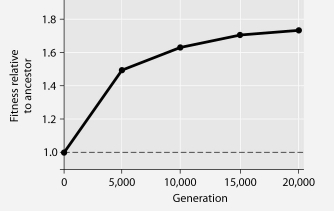Question 47
(Multiple Choice)
The following questions refer to Figure 27.1.
In this eight-year experiment, 12 populations of E. coli, each begun from a single cell, were grown in low-glucose conditions for 20,000 generations. Each culture was introduced to fresh growth medium every 24 hours. Occasionally, samples were removed from the populations, and their fitness in low-glucose conditions was tested against that of members sampled from the ancestral (common ancestor) E. coli population.

Figure 27.1
-If the experimental population of E. coli lacks an F factor or F plasmid, and if bacteriophages are excluded from the bacterial cultures, then which of these is (are)means by which beneficial mutations might be transmitted horizontally to other E. coli cells?
A) via sex pili
B) via transduction
C) via conjugation
D) via transformation
E) Two of the responses above are correct.
Answer